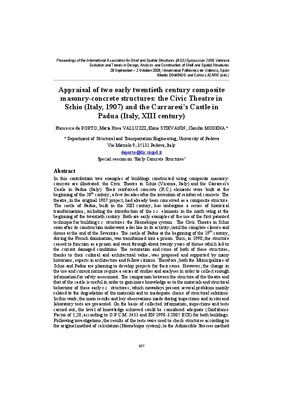JavaScript is disabled for your browser. Some features of this site may not work without it.
Buscar en RiuNet
Listar
Mi cuenta
Estadísticas
Ayuda RiuNet
Admin. UPV
Appraisal of two early twentiech century composite masonry-concrete structures: the Civic Theatre in Schio (Italy 1907) and Carraresi's Castle in Padua (Italy, XIII century)
Mostrar el registro sencillo del ítem
Ficheros en el ítem
| dc.contributor.author | DA PORTO, Francesca
|
|
| dc.contributor.author | VALLUZZI, Maria Rosa
|
|
| dc.contributor.author | STIEVANIN, Elena
|
|
| dc.contributor.author | MODENA, Claudio
|
|
| dc.contributor.editor | Domingo Cabo, Alberto
|
es_ES |
| dc.contributor.editor | Lázaro Fernández, Carlos Manuel
|
es_ES |
| dc.date.accessioned | 2009-12-18T12:24:49Z | |
| dc.date.available | 2009-12-18T12:24:49Z | |
| dc.date.issued | 2009-12-18T12:24:49Z | |
| dc.identifier.isbn | 978-84-8363-461-5 | |
| dc.identifier.uri | http://hdl.handle.net/10251/6730 | |
| dc.description | p. 697-709 | en_EN |
| dc.description.abstract | In this contribution two examples of buildings constructed using composite masonryconcrete are illustrated: the Civic Theatre in Schio (Vicenza, Italy) and the Carraresi's Castle in Padua (Italy). Their reinforced concrete (R.C.) elements were built at the beginning of the 20th century, a few decades after the invention of reinforced concrete. The theatre, in the original 1907 project, had already been conceived as a composite structure. The castle of Padua, built in the XIII century, has undergone a series of historical transformations, including the introduction of the r.c. elements in the north wing at the beginning of the twentieth century. Both are early examples of the use of the first patented technique for building r.c. structures: the Hennebique system . The Civic Theatre in Schio soon after its construction underwent a decline in its activity, until the complete closure and disuse at the end of the Seventies. The castle of Padua at the beginning of the 19th century, during the French domination, was transformed into a prison. Then, in 1990, the structure ceased to function as a prison and went through about twenty years of disuse which led to the current damaged conditions. The restoration and reuse of both of these structures, thanks to their cultural and architectural value, was proposed and supported by many historians, experts in architecture and fellow citizens. Therefore, both the Municipalities of Schio and Padua are planning to develop projects for their reuse. However, the change in the use and current norms require a series of studies and analyses in order to collect enough information for safety assessment. The comparison between the structure of the theatre and that of the castle is useful in order to gain more knowledge as to the materials and structural behaviour of these early r.c. structures, which nowadays present several problems mainly related to the degradation of the materials and to inadequate choice of structural solutions. In this work, the main results and key observations made during inspections and in situ and laboratory tests are presented. On the basis of collected information, inspections and tests carried out, the level of knowledge achieved could be considered adequate (Confidence Factor of 1,20, according to O.P.C.M. 3431 and EN 1998-3:2005 EC8) for both buildings. Following investigations, the results of the tests were used to check structures according to the original method of calculation (Hennebique system), to the Admissible Stresses method and to the Ultimate and Serviceability Limit State method. The safety assessment, required by changes in the use and by current norms, showed that both structures examined need strengthening repairs. Thus, in general, it is possible to say that most of the historic R.C. buildings need repairs to verify nowadays safety requirements. | en_EN |
| dc.language | Inglés | en_EN |
| dc.publisher | Editorial Universitat Politècnica de València | es_ES |
| dc.relation.ispartof | Symposium of the International Association for Shell and Spatial Structures (50th. 2009. Valencia). Evolution and Trends in Design, Analysis and Construction of Shell and Spatial Structures : Proceedings | en_EN |
| dc.rights | Reserva de todos los derechos | en_EN |
| dc.subject | Historic concrete | en_EN |
| dc.subject | Test | en_EN |
| dc.subject | Hennebique system | en_EN |
| dc.subject | Admissible stresses | en_EN |
| dc.subject | Limit states | en_EN |
| dc.subject | Assessment | en_EN |
| dc.subject | Checks | en_EN |
| dc.subject | Confidence factors | en_EN |
| dc.title | Appraisal of two early twentiech century composite masonry-concrete structures: the Civic Theatre in Schio (Italy 1907) and Carraresi's Castle in Padua (Italy, XIII century) | en_EN |
| dc.type | Comunicación en congreso | en_EN |
| dc.rights.accessRights | Abierto | es_ES |
| dc.description.bibliographicCitation | Da Porto, F.; Valluzzi, MR.; Stievanin, E.; Modena, C. (2009). Appraisal of two early twentiech century composite masonry-concrete structures: the Civic Theatre in Schio (Italy 1907) and Carraresi's Castle in Padua (Italy, XIII century). Editorial Universitat Politècnica de València. http://hdl.handle.net/10251/6730 | es_ES |
| dc.relation.conferencename | Symposium of the International Association for Shell and Spatial Structures | es_ES |
| dc.relation.conferencedate | 2009 | es_ES |
| dc.relation.conferenceplace | Valencia | es_ES |






